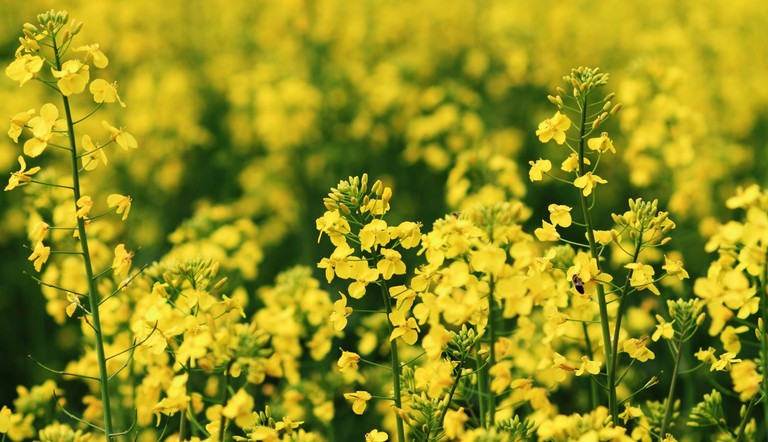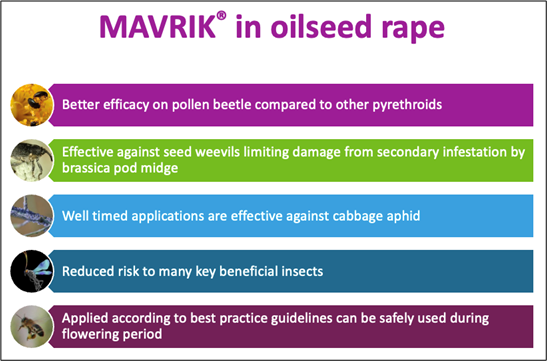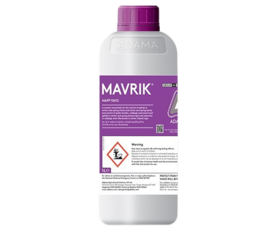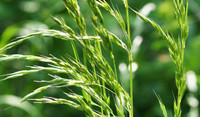
Safeguarding beneficials to control late season OSR pests

Fortunately, it is economically possible to safeguard against pests such as seed weevils and pod midges by applying a suitable insecticide once the relevant pest threshold has been reached and, where additional control is needed, to use products that maximise the natural predatory effect of beneficial organisms.
As winter oilseed rape crops start to flower, pollen beetles remain a risk only in the most backward or low-density crops. However, growers and agronomists should still be on the lookout for cabbage seed weevil activity at this time, especially as these insects have the potential to cause significant yield losses, not only as a result of the direct damage caused by laying their eggs in developing seed pods, but also by subsequent populations of brassica pod midges which use the holes left by the hatched weevil larvae to access rapeseed pods and lay their own eggs.
Growers in known seed weevil hotspots (for example Yorkshire and Lincolnshire) should be particularly vigilant and are advised to use integrated pest management protocols to safeguard the natural predatory effect of beneficial organisms.
As the 2023 season progresses, it is also advisable to monitor for the presence of mealy cabbage aphids as numbers are anticipated to be high following the widespread infestations of late 2022. Although usually more problematic in spring-sown crops of OSR rather than winter crops, they can have an impact on both with typical yield losses (once population thresholds have been exceeded) ranging from 0.07 to 0.62 t/ha and averaging at 0.2 t/ha. Oil content will also be compromised in affected crops, with an average reduction of 0.5% commonplace, but with the scope for oil content to be reduced by as much as 3.5%. The key scouting times for this pest are at yellow bud and just before petal fall.
Pollen beetle treatment thresholds (at the green-to-yellow bud stage):
Fewer than 30 plants/m2: 25 beetles per plant
30-50 plants/m2: 18 beetles per plant
50-70 plants/m2: 11 beetles per plant
More than 70 plants/m2: 7 beetles per plant
Cabbage seed weevil treatment thresholds:
Northern UK: one seed weevil in every two plants
Elsewhere: one per plant
Mealy cabbage aphid infestation thresholds:
Winter oilseed rape: more than 4% of plants infested by the yellow bud stage
Winter oilseed rape: more than 13% of plants infested before petal fall
Spring oilseed rape: more than 4% of plant infested before petal fall
If/when these infestation rates have been exceeded, apply MAVRIK at 0.2l/ha in a water volume of 200l/ha.
Irrespective of the pest being targeted, the best levels of control will be achieved when treatments are promptly timed and applied in such a way that ensures good spray coverage. Early applications (once thresholds have been reached) will also enable beneficial insects to migrate into the crop where they can limit the extent of any subsequent reinfestations.
Applying MAVRIK early in the lifecycle of pest infestations reduces the potential impact on beneficial insects arriving after the insecticide has been applied.
To maximise the benefit of these beneficial insects, a pesticide with a lower residual impact on advantageous predators should be used: if a pyrethroid-based insecticide is deemed to be the most appropriate mode of action, growers should choose MAVRIK (240 g/litre tau-fluvalinate) as it not only provides fast-acting contact control, but has also been proven to have a lower residual impact on beneficial insects compared to other pyrethroids.
This reduced toxicity enables natural predators to recover more quickly after crops have been sprayed, therefore ensuring there’s a strong population of predators ready and able to overcome any subsequent infestations.



MAVRIK (240 g/litre tau-fluvalinate) is a highly active and novel pyrethroid which has less impact on beneficial organisms such as honeybees compared to other pyrethroid insecticides. It provides effective, fast-acting contact control of aphids, pollen beetle and cabbage seed weevil.


